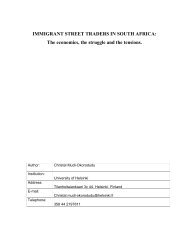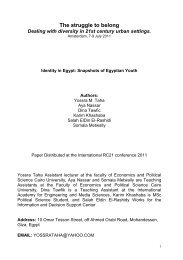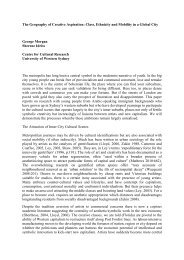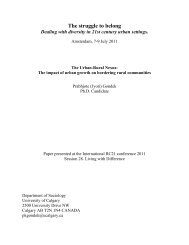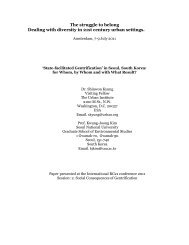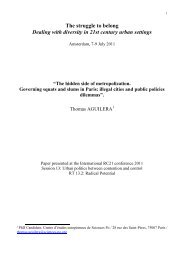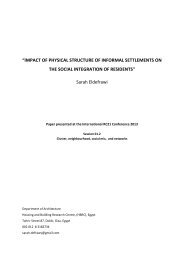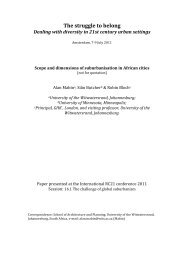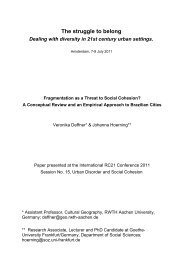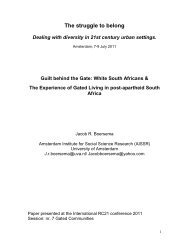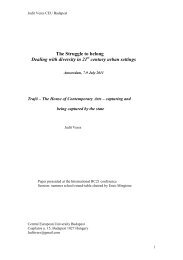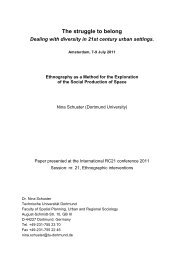Gentrification in the mill land areas of Mumbai city - RC21 ORG ...
Gentrification in the mill land areas of Mumbai city - RC21 ORG ...
Gentrification in the mill land areas of Mumbai city - RC21 ORG ...
Create successful ePaper yourself
Turn your PDF publications into a flip-book with our unique Google optimized e-Paper software.
people are claim<strong>in</strong>g <strong>the</strong>ir rights to hous<strong>in</strong>g. These houses <strong>of</strong> 325 square feet <strong>in</strong> area have been<br />
allotted on <strong>the</strong> basis <strong>of</strong> lottery system. The <strong>mill</strong> workers from rural and urban area and <strong>the</strong>ir<br />
<strong>of</strong>f spr<strong>in</strong>gs are claim<strong>in</strong>g to live near <strong>the</strong> <strong>city</strong> centre due to its locational advantage. As <strong>the</strong><br />
transnational elites came <strong>in</strong>to <strong>the</strong> <strong>mill</strong> <strong>land</strong> ei<strong>the</strong>r to reside or for commercial purposes,<br />
similarly <strong>the</strong> workers from <strong>the</strong> urban and <strong>the</strong> rural are claim<strong>in</strong>g <strong>the</strong>ir right to live <strong>in</strong> <strong>the</strong> <strong>city</strong>.<br />
Therefore <strong>the</strong>re is a formation <strong>of</strong> two different worlds with<strong>in</strong> <strong>the</strong> <strong>city</strong> due to <strong>the</strong> <strong>in</strong>ternal<br />
contradictions. Massey, Allen & Pile (1999:53) describes as “worlds with<strong>in</strong> cities” which<br />
Sassen (1993) put forward <strong>the</strong> question <strong>of</strong> existence <strong>of</strong> <strong>the</strong>se different worlds, <strong>the</strong> question <strong>of</strong><br />
presupposition regard<strong>in</strong>g <strong>the</strong> co existence <strong>of</strong> <strong>the</strong> different worlds with<strong>in</strong> <strong>the</strong> same <strong>city</strong>, <strong>the</strong><br />
ty<strong>in</strong>g up <strong>of</strong> <strong>the</strong>se different worlds. To Harvey (1998:9) this break<strong>in</strong>g <strong>of</strong> cities <strong>in</strong>to parts is<br />
known as ‘microstates’. Harvey (2008:1) once cited sociologist Robert Park who conveyed,<br />
“man’s most consistent and on <strong>the</strong> whole, his most successful attempt to remake <strong>the</strong> world he<br />
lives <strong>in</strong> more after his heart’s desire. But, if <strong>the</strong> <strong>city</strong> is <strong>the</strong> world which man has created, it is<br />
<strong>the</strong> world <strong>in</strong> which he is hence forth condemned to live. Thus <strong>in</strong>directly, and without any<br />
clear sense <strong>of</strong> <strong>the</strong> nature <strong>of</strong> his task, <strong>in</strong> mak<strong>in</strong>g <strong>the</strong> <strong>city</strong> man has remade himself.” Therefore<br />
<strong>the</strong> k<strong>in</strong>d <strong>of</strong> <strong>city</strong> we want depends on <strong>the</strong> k<strong>in</strong>d <strong>of</strong> people we want to be, <strong>the</strong> relationship we<br />
aspire, <strong>the</strong> livelihoods we desire. In an aspir<strong>in</strong>g global <strong>city</strong> like <strong>Mumbai</strong>, where <strong>city</strong> space<br />
gets reoriented by <strong>the</strong> process <strong>of</strong> excessive valorisation <strong>of</strong> <strong>the</strong> corporate world and<br />
devalorisation <strong>of</strong> <strong>the</strong> ethnic world as a process <strong>of</strong> ‘creative destruction’ (Harvey, 1990:425) it<br />
is due to <strong>the</strong> uneven development and capitalist process <strong>of</strong> accumulation <strong>of</strong> surplus <strong>in</strong> <strong>the</strong> <strong>city</strong><br />
space that is caus<strong>in</strong>g <strong>the</strong> bourgeoisie revanchism and it gets reflected <strong>in</strong> <strong>the</strong> everyday life <strong>of</strong><br />
<strong>the</strong> people. The everyday life gets reconstituted <strong>in</strong> <strong>the</strong> process <strong>of</strong> gentrification where<br />
exclusion and <strong>in</strong>clusion <strong>of</strong> different th<strong>in</strong>gs become a way <strong>of</strong> life. Study<strong>in</strong>g <strong>the</strong> multiple layers<br />
<strong>of</strong> <strong>city</strong> space <strong>of</strong> <strong>Mumbai</strong> and <strong>the</strong> process <strong>of</strong> gentrification, <strong>the</strong> <strong>in</strong>formal activities are also<br />
taken <strong>in</strong>to account. The paper also br<strong>in</strong>gs out <strong>the</strong> <strong>in</strong>formality that occurs <strong>in</strong> <strong>the</strong> neighbourhood<br />
on a daily basis <strong>in</strong> <strong>the</strong> process <strong>of</strong> transformation and its implication on <strong>the</strong> fragmentation <strong>of</strong><br />
<strong>the</strong> <strong>city</strong> space.<br />
Acknowledgement<br />
I would like to express my gratitude to my guide Pr<strong>of</strong>. Kushal Deb and co-guide Pr<strong>of</strong>. D.<br />
Parthasarathy for <strong>the</strong>ir constant support and guidance. I would also like to thank my fellow<br />
researchers for all <strong>the</strong>ir useful comments and wonderful reviews.



